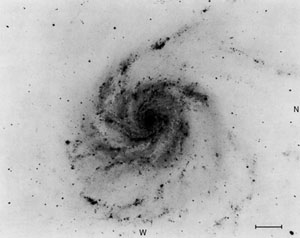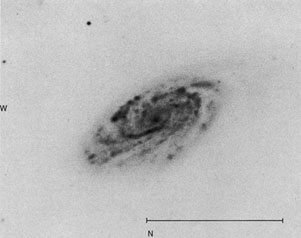


Galaxies of this luminosity class have a well-defined global spiral pattern, which appears at first glance to be highly regular. In the cases of NGC 4321 (M 100), NGC 628, and NGC 3294, there exist two principal arms emerging from the central regions. These are thin and well formed for nearly three-fourths of a revolution. The arms do, however, branch in the outer regions, where they appear to be composed of separate fragments rather than to be coherent structures of a double-arm system.
The fragmentation and branching is especially well seen in NGC 1232, the brightest galaxy shown here. The fragmentation is also pronounced over the outer two-thirds of M101.
The two very regular arms in NGC 5364 are relatively easy to trace in the outer regions, although the SW major arm is fragmented there. However, the connections of these arms onto the inner ring suggest that they cross one another near the ring at the NE major axis. Some color is given to this suggestion by the absorption pattern of one arm as it is silhouetted against the other near this crossing.
The first five galaxies in the panel are within ~ 1 mag of the same absolute luminosity. The faintest galaxy (NGC 3294) is 1.8 mag fainter than NGC 1232.

NGC 1232 P200-74-H Sc(rs)I -22m.57 1782 km/s | 
NGC 4321 M100 P200-3562-S Sc(s)I -21m.91V 1568 km/s | 
|

NGC 628 P200-16-MH Sc(s)I -21m.75 656 km/s | 
NGC 5457 M101 P200-401-B Sc(s)I -21m.51 M 251 km/s | |

NGC 5364 P200-51-H Sc(r)I -21m.46 1256 km/s | 
NGC 3294 W100-2330-H Sc(s)I.3 -20m.79 1571 km/s |